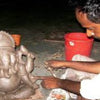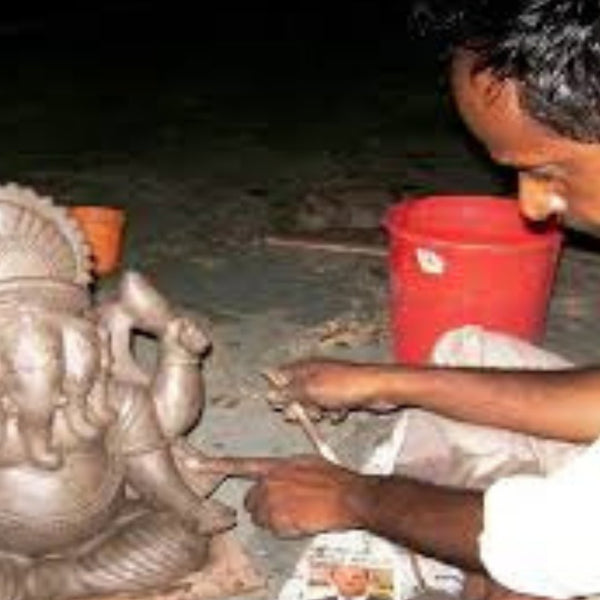Terracotta
Terracotta artwork, one of the oldest forms of artistic expression, is crafted from natural clay and fired to achieve a durable and earthy finish. Known for its rustic charm, terracotta art encompasses a wide range of objects, including sculptures, pottery, decorative items, and architectural elements. This art form is celebrated for its versatility and accessibility, allowing artists to mold intricate details and create pieces that reflect both cultural heritage and contemporary aesthetics. Terracotta art is not only a reflection of human creativity but also a link to ancient civilizations, showcasing how art and everyday life were intertwined.
Terracotta art often draws inspiration from nature, mythology, and everyday life. Common themes include animals, birds, deities, and human figures, often depicted with a blend of realism and stylization. In many cultures, terracotta is used to create votive figures and ceremonial objects, reflecting the deep spiritual connection between the art form and religious practices. In contemporary times, terracotta artists have expanded their themes to include abstract and modern designs, exploring new expressions while still honoring traditional roots. Whether as decorative elements or symbolic artifacts, terracotta artworks often tell stories that resonate with both historical significance and personal meaning.
History
The history of terracotta art dates back thousands of years, with its origins rooted in ancient civilizations such as the Indus Valley, Mesopotamia, and Egypt. In India, terracotta has been a significant part of cultural and religious practices since the Harappan period. The craft flourished in various regions, each developing distinct styles and techniques influenced by local customs, beliefs, and natural resources. Over centuries, terracotta evolved from a utilitarian craft, producing everyday objects like vessels and bricks, to an artistic medium for creating intricate sculptures, temple decorations, and ritualistic objects. Despite the advent of new materials and technologies, terracotta art has retained its relevance, continuing to captivate with its timeless appeal.
Materials and Methods
The primary material used in terracotta art is clay, which is collected, purified, and kneaded to achieve the desired consistency. Artists often blend different types of clay to enhance the durability and workability of their pieces. The creation process involves molding the clay by hand, using tools, or employing molds for specific shapes. Once shaped, the objects are dried slowly to prevent cracking, and then fired in a kiln at high temperatures to harden them. Depending on the desired finish, pieces may be left in their natural state, burnished, or painted with natural pigments. Traditional methods are often passed down through generations, preserving the authenticity and skill involved in this craft.
Terracotta artwork is characterized by its varied styles, which differ from region to region. For example, the Molela terracotta plaques from Rajasthan are known for their vibrant depictions of folk deities and village scenes, while the Bankura horses from West Bengal are celebrated for their stylized forms and rhythmic proportions. The styles can range from highly detailed and ornate to simple and minimalistic, each reflecting the cultural identity of the area it originates from. The surface of terracotta pieces can be left unglazed to retain a raw, earthy texture, or it can be polished and painted to add color and sheen. The adaptability of terracotta allows artists to experiment with forms, finishes, and decorative techniques, resulting in a diverse array of artistic expressions.
Significance
Terracotta art holds a significant place in the cultural and artistic heritage of many societies. It is a sustainable art form that utilizes natural materials, making it environmentally friendly and accessible. Beyond its aesthetic appeal, terracotta has practical uses in daily life and serves as a medium for storytelling and religious expression. The tactile nature of terracotta connects the artist and the viewer to the earth, imbuing each piece with a sense of origin and permanence. In modern contexts, terracotta continues to thrive as a symbol of tradition and adaptability, bridging the past and present. The art form not only provides livelihood opportunities for artisans but also plays a crucial role in preserving intangible cultural heritage, ensuring that the legacy of terracotta art endures through time.
FAQs
Can I customize a terracotta piece?
MeMeraki offers customization options for terracotta artwork, allowing you to request specific sizes, colors, or themes. Please contact our customer service or the artisan directly through our platform for more details on customization availability.
Why are some terracotta products priced higher than others?
Prices of terracotta products can vary based on factors such as the complexity of the design, size, level of detailing, and the time required to create the piece. Artisanship, rarity, and the use of specific traditional methods also contribute to the value of the artwork.
How do I display terracotta artwork in my home?
Terracotta artwork can be displayed on shelves, tabletops, or as part of a curated collection. For larger pieces like sculptures, a dedicated space or pedestal can enhance their visual impact. Ensure that the display area is stable and away from high-traffic zones to avoid accidental damage.
![]() Get Upto 10% OFF on purchase of this product.
Get Upto 10% OFF on purchase of this product.
![]() Get upto 10% OFF on Live Workshops when sign up for 2 or more workshops.
Get upto 10% OFF on Live Workshops when sign up for 2 or more workshops.
![]() Get 10% OFF coupon code for Art Kits signing up for Masterclass or Live Workshop.
Get 10% OFF coupon code for Art Kits signing up for Masterclass or Live Workshop.
![]() Earn upto 2,499 Points on purchase of this product.
Earn upto 2,499 Points on purchase of this product.











